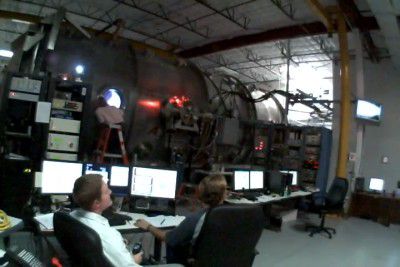From our front-page news:
Getting humans to Mars is something that's on a lot of minds, especially astronauts and space scientists, but understandably, the number of hurdles in our way is seemingly innumerable. The biggest issue is space radiation, which is caused by all of the cosmic rays shot forth by the stars in our galaxy - especially the Sun when we're talking about close to home. Although sending people to the moon is an incredible feat, the risk of radiation causing issues to the astronauts is relatively low, given the required amount of time to reach the destination.
Mars is another story. While the Moon sits at about 240,000 Km from our Earth, Mars at any given time can be 30,000,000 Km away, and that's the minimum distance. Using similar rockets that get us to the Moon, getting to Mars would take at least 6 months, which is a major issue where space radiation is concerned. Astronauts may be safe for a little while, but we're talking six months... not a mere week.
But a company from Texas hopes to have something that will improve not only the goal of making it to Mars, but other space activities as well. Their new "VASIMR" rocket, with plasma-based propulsion, is capable of producing thrust unseen by any other current rocket technologies. What would this mean for a Mars expedition? A 39 day trip, rather than 6 months. That's a huge difference.
Of course, VASIMR has other uses as well. NASA has already signed up for use of the technology by 2013 to aide with occasional repositioning of the International Space Station, and even missions to the Moon would be made much easier with VASIMR. Aside from the obvious performance improvements, VASMIR also manages to cut down on fuel by a very large degree. While NASA uses 7.5 tonnes of fuel per year for the ISS boosters alone, VASIMR can cut that down to 0.3 tonnes. That's insane!

But Ad Astra has bigger plans for VASIMR, such as high-speed missions to Mars. A 10- to 20-megawatt VASIMR engine could propel human missions to Mars in just 39 days, whereas conventional rockets would take six months or more. The shorter the trip, the less time astronauts would be exposed to space radiation, which is a significant hurdle for Mars missions. VASIMR could also be adapted to handle the high payloads of robotic missions, though at slower speeds than lighter human missions.
Source: PhysOrg
Mars is another story. While the Moon sits at about 240,000 Km from our Earth, Mars at any given time can be 30,000,000 Km away, and that's the minimum distance. Using similar rockets that get us to the Moon, getting to Mars would take at least 6 months, which is a major issue where space radiation is concerned. Astronauts may be safe for a little while, but we're talking six months... not a mere week.
But a company from Texas hopes to have something that will improve not only the goal of making it to Mars, but other space activities as well. Their new "VASIMR" rocket, with plasma-based propulsion, is capable of producing thrust unseen by any other current rocket technologies. What would this mean for a Mars expedition? A 39 day trip, rather than 6 months. That's a huge difference.
Of course, VASIMR has other uses as well. NASA has already signed up for use of the technology by 2013 to aide with occasional repositioning of the International Space Station, and even missions to the Moon would be made much easier with VASIMR. Aside from the obvious performance improvements, VASMIR also manages to cut down on fuel by a very large degree. While NASA uses 7.5 tonnes of fuel per year for the ISS boosters alone, VASIMR can cut that down to 0.3 tonnes. That's insane!

But Ad Astra has bigger plans for VASIMR, such as high-speed missions to Mars. A 10- to 20-megawatt VASIMR engine could propel human missions to Mars in just 39 days, whereas conventional rockets would take six months or more. The shorter the trip, the less time astronauts would be exposed to space radiation, which is a significant hurdle for Mars missions. VASIMR could also be adapted to handle the high payloads of robotic missions, though at slower speeds than lighter human missions.
Source: PhysOrg
